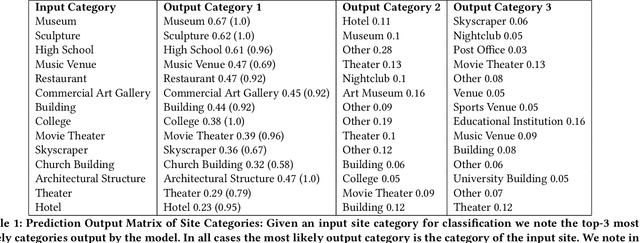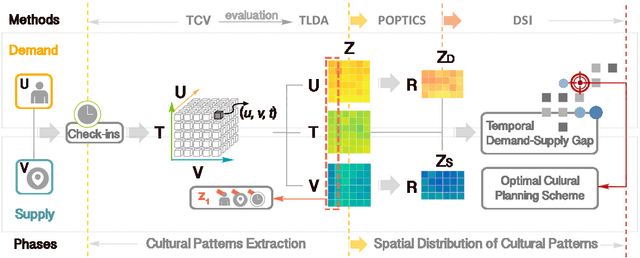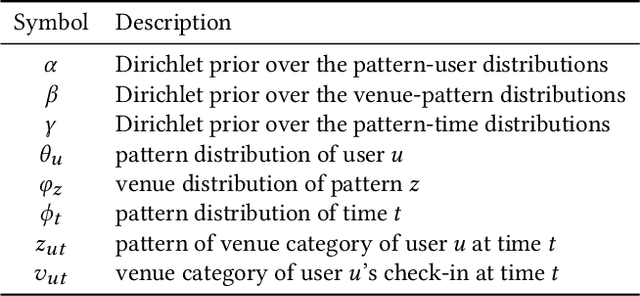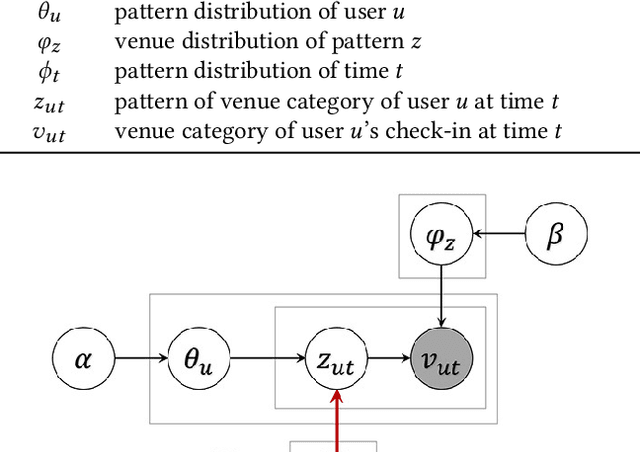Anastasios Noulas
Modelling Urban Dynamics with Multi-Modal Graph Convolutional Networks
Apr 29, 2021



Abstract:Modelling the dynamics of urban venues is a challenging task as it is multifaceted in nature. Demand is a function of many complex and nonlinear features such as neighborhood composition, real-time events, and seasonality. Recent advances in Graph Convolutional Networks (GCNs) have had promising results as they build a graphical representation of a system and harness the potential of deep learning architectures. However, there has been limited work using GCNs in a temporal setting to model dynamic dependencies of the network. Further, within the context of urban environments, there has been no prior work using dynamic GCNs to support venue demand analysis and prediction. In this paper, we propose a novel deep learning framework which aims to better model the popularity and growth of urban venues. Using a longitudinal dataset from location technology platform Foursquare, we model individual venues and venue types across London and Paris. First, representing cities as connected networks of venues, we quantify their structure and note a strong community structure in these retail networks, an observation that highlights the interplay of cooperative and competitive forces that emerge in local ecosystems of retail businesses. Next, we present our deep learning architecture which integrates both spatial and topological features into a temporal model which predicts the demand of a venue at the subsequent time-step. Our experiments demonstrate that our model can learn spatio-temporal trends of venue demand and consistently outperform baseline models. Relative to state-of-the-art deep learning models, our model reduces the RSME by ~ 28% in London and ~ 13% in Paris. Our approach highlights the power of complex network measures and GCNs in building prediction models for urban environments. The model could have numerous applications within the retail sector to better model venue demand and growth.
Modelling Cooperation and Competition in Urban Retail Ecosystems with Complex Network Metrics
Apr 28, 2021



Abstract:Understanding the impact that a new business has on the local market ecosystem is a challenging task as it is multifaceted in nature. Past work in this space has examined the collaborative or competitive role of homogeneous venue types (i.e. the impact of a new bookstore on existing bookstores). However, these prior works have been limited in their scope and explanatory power. To better measure retail performance in a modern city, a model should consider a number of factors that interact synchronously. This paper is the first which considers the multifaceted types of interactions that occur in urban cities when examining the impact of new businesses. We first present a modeling framework which examines the role of new businesses in their respective local areas. Using a longitudinal dataset from location technology platform Foursquare, we model new venue impact across 26 major cities worldwide. Representing cities as connected networks of venues, we quantify their structure and characterise their dynamics over time. We note a strong community structure emerging in these retail networks, an observation that highlights the interplay of cooperative and competitive forces that emerge in local ecosystems of retail establishments. We next devise a data-driven metric that captures the first-order correlation on the impact of a new venue on retailers within its vicinity accounting for both homogeneous and heterogeneous interactions between venue types. Lastly, we build a supervised machine learning model to predict the impact of a given new venue on its local retail ecosystem. Our approach highlights the power of complex network measures in building machine learning prediction models. These models have numerous applications within the retail sector and can support policymakers, business owners, and urban planners in the development of models to characterize and predict changes in urban settings.
Mobile Recognition of Wikipedia Featured Sites using Deep Learning and Crowd-sourced Imagery
Nov 04, 2019



Abstract:Rendering Wikipedia content through mobile and augmented reality mediums can enable new forms of interaction in urban-focused user communities facilitating learning, communication and knowledge exchange. With this objective in mind, in this work we develop a mobile application that allows for the recognition of notable sites featured on Wikipedia. The application is powered by a deep neural network that has been trained on crowd-sourced imagery describing sites of interest, such as buildings, statues, museums or other physical entities that are present and visually accessible in an urban environment. We describe an end-to-end pipeline that describes data collection, model training and evaluation of our application considering online and real world scenarios. We identify a number of challenges in the site recognition task which arise due to visual similarities amongst the classified sites as well as due to noise introduce by the surrounding built environment. We demonstrate how using mobile contextual information, such as user location, orientation and attention patterns can significantly alleviate such challenges. Moreover, we present an unsupervised learning technique to de-noise crowd-sourced imagery which improves classification performance further.
Discovering Latent Patterns of Urban Cultural Interactions in WeChat for Modern City Planning
Jun 14, 2018



Abstract:Cultural activity is an inherent aspect of urban life and the success of a modern city is largely determined by its capacity to offer generous cultural entertainment to its citizens. To this end, the optimal allocation of cultural establishments and related resources across urban regions becomes of vital importance, as it can reduce financial costs in terms of planning and improve quality of life in the city, more generally. In this paper, we make use of a large longitudinal dataset of user location check-ins from the online social network WeChat to develop a data-driven framework for cultural planning in the city of Beijing. We exploit rich spatio-temporal representations on user activity at cultural venues and use a novel extended version of the traditional latent Dirichlet allocation model that incorporates temporal information to identify latent patterns of urban cultural interactions. Using the characteristic typologies of mobile user cultural activities emitted by the model, we determine the levels of demand for different types of cultural resources across urban areas. We then compare those with the corresponding levels of supply as driven by the presence and spatial reach of cultural venues in local areas to obtain high resolution maps that indicate urban regions with lack of cultural resources, and thus give suggestions for further urban cultural planning and investment optimisation.
 Add to Chrome
Add to Chrome Add to Firefox
Add to Firefox Add to Edge
Add to Edge